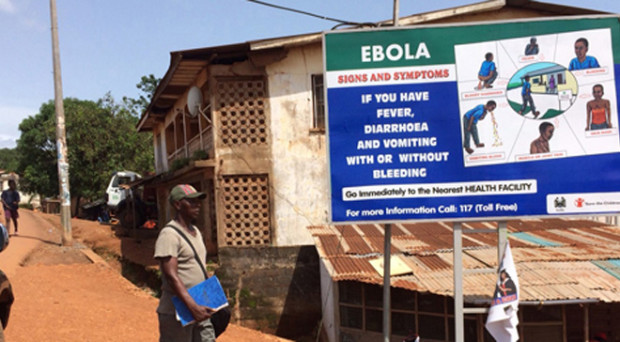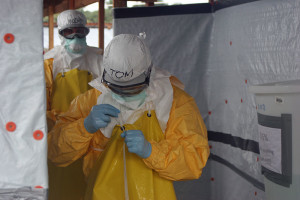
Last year’s Ebola crisis first broke in Guinea in February, 2014. The Ebola Virus Disease (EBV, described previously) soon spread to 9 countries, claiming over 11,000 lives with the majority occurring across three countries in West Africa- Sierra Leone, Liberia and Guinea. The devastating outbreak has indirectly impacted the affected regions in many ways, including increasing malaria transmission, cases and mortality.
What is more, this devastating outbreak has indirectly impacted the affected regions in many other ways. A year later the situation is under much better control, however transmission is still ongoing. In a recent blog, PhD student (LSHTM) Allie Robinson recounted her experiences during her deployment to Sierra-Leone as a diagnostician.
So far this month only 5 new cases have been reported- the lowest figure since the outbreak started a year ago. This is essentially a result of stringent control programmes focusing on strengthening capacity building for contact tracing and case investigations.

Complications and knock-on effects
The scale of the outbreak was largely due to the complete breakdown of the local health systems. This of course had knock-on effects on other diseases that plague those areas. For example, many maternity wards were forced to completely shut down due to the high risk of transmission of Ebola from patient to health care workers during birth. In a setting where maternal and neonatal mortality from childbirth is amongst the highest in the world, the lack of access to such valuable services is a serious cause for concern. It is a similar situation with regards to diagnosing and treating the diarrhoeal, and respiratory diseases that are common in these countries.
Aside from health care centres being overwhelmed by the sheer number of patients- aggravated by the loss of staff to EVD- Malaria transmission, cases and mortality were affected by further complications. Febrile patients became reluctant to attend health centres as they became regarded as “a place you go to die”, discouraging malaria sufferers from seeking treatment and often visiting traditional healers instead. Even where they did attend clinics, technicians were apprehensive about drawing blood for microscopy to diagnose malaria.
Several violent riots and incidents of looting took place at health centres and hospitals across the 3 main countries, resulting in further disruption of the control programmes. Suspicion and anger arose when locals were lead to believe that medical staff were somehow responsible for bringing EVD to their villages, leading to attacks on medical staff and vehicles delivering bed nets. Further suspicion arose around the usage of bednets when it was recommended that bednets belonging to EVD victims be buried with them.
WHO response for malaria control
Recognising that Ebola response programmes could be enhanced by a reduction in febrile cases, the WHO published guidelines for temporary measures for malaria control in Ebola affected countries. The guidelines focus on deploying non-frontline long-lasting ACTs through emergency mass drug administration campaigns, with the aim of 1. Reducing malaria morbidity and mortality, 2. Reducing non-EVD febrile cases and 3. Protecting frontline healthcare workers dealing with these diseases.

Modelling the effects on malaria morbidity and mortality
The probable effect of such campaigns have been analysed by Walker et al, 2015. They model the effects of the decreased health-care capacity in Ebola-affected countries on malaria morbidity, mortality, and analyse the potential effect of mitigation strategies advised by the WHO guidelines.
Their model multiplies age-stratified case incidence and age-stratified population estimates for each administrative unit to estimate the number of additional malaria cases caused by the Ebola outbreak. Their figures show a total of 3.5 million additional cases of untreated malaria cases, most of which would normally occur but would normally be treated. Only a small proportion of these were due to the increased transmission as a result of the cessation of malaria treatment.
They found that cessation of bed net distribution would have a more profound effect on numbers of additional malaria cases and that this would be exacerbated if distribution did not recover before the rainy season in 2015, resulting in a further 2.7 million cases.

To estimate how these values translate to mortality by malaria, they multiply mortality by population size, taking into account the age distribution of the population of the malaria cases in each administrative unit to calculate the number of malaria- attributable deaths. They estimate 10,900 additional malaria-attributable mortalities in the absence of clinic and hospital care, with a further 3,900 fatalities due to the disruption in bednet distribution. Should the healthcare provision recover to a level of those before the outbreak, they still predict 31,800 deaths from malaria in 2015.
They also show the effect of mass drug administration regime administering dihydroartemesinin-piperaquine for 6 months in January 2015 would result in the lowest number of malaria-attributable deaths when compared to 3 month regimes at various times of the year. These data assume that the health system is still disrupted and a 70% coverage rate.
Overall, their models reveal the importance of getting health systems up and running as soon as possible, so that we can start tackling all of the diseases neglected during the outbreak. This effort will be absolutely necessary if we are to prevent the undoing of decades of disease control programmes and continue on our path toward elimination.

Comments